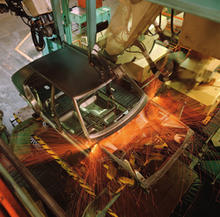Manufacturing Innovation Through Supply Chain Integration
(+$2 million)
Problem/Challenge

Everyone has experienced the occasional headache in sharing or moving data from one computer to another, but in the nation's manufacturing and construction industries, it is a multibillion-dollar problem.
America's large manufacturers are globally distributed enterprises that rely on a system of small manufacturers, parts suppliers, shippers, and raw materials producers organized in extended "supply chains." The U.S. construction industry is made up of an equally diverse network of more than 1 million firms. Using the auto industry as an example, the average car has more than 15,000 parts coming from 5,000 manufacturers that must arrive on time, made to the precise specifications of the auto company.
Production costs are no longer the major cost component in these global supply chains—the dominant cost is in the engineering and business activities, which depend critically upon clear and error-free exchange of information among partners.
Inefficiencies and needless roadblocks in the exchange of product design and business data in manufacturing and construction are estimated to cost the U.S. economy more than $25 billion per year. Small manufacturers are particularly hurt by these problems, but they affect the competitiveness of entire industries.
Proposed NIST Program
In the 1980s NIST pioneered work in developing open standards for data exchange. Under this initiative, NIST will conduct a much more extensive and wide-ranging program, working closely with U.S. manufacturers, to develop seamless data transactions throughout global supply chains—shortening the design-to-manufacturing cycle, improving quality, and lowering costs for large and small U.S. firms.
Major goals will include:
- creating "roadmaps" for the development of open standards for enterprise integration in target industry sectors;
- developing conformance tests to help ensure the proper use of these standards; and
- ensuring the standards are integrated and consistent with developing international standards and easily available to small and medium-sized U.S. manufacturers.
This work also addresses the requirements of the Enterprise Integration Act of 2002.
Expected Impacts
A robust, widely accepted framework of standards for enterprise integration will help open the global marketplace to the nation's small manufacturers.
Other potential benefits include:
- savings of approximately $1 billion in enterprise integration costs for U.S. manufacturers and producers in target industries;
- a 20 percent reduction in "time-to-market" for manufacturers and producers in target industries;
- a 50 percent reduction in information technology costs for small and medium-sized manufacturers in target industries; and
- spillover benefits to other industries, including electronics, shipbuilding, furniture manufacturers, chemicals production, textiles, and apparel.

